How Long Do Body Shops Take To Fix Cars?

How Long Do Body Shops Take To Fix Cars? Understanding auto body repair timelines, related services, and potential advantages of professional repairs is essential. At CARDIAGTECH.NET, we provide solutions to help you navigate these situations with knowledge and confidence. Explore how car repair duration impacts vehicle condition and performance, ensuring satisfaction and safety with every repair.
1. Understanding the Timeframe for Car Body Repairs
When accidents happen, getting your car fixed quickly becomes a top priority. But how long do body shops take to fix cars? The answer isn’t always straightforward. It depends on various factors, from the extent of the damage to the availability of parts. Let’s break down the typical timelines for different types of auto body repairs.
| Repair Type | Average Time | Description |
|---|---|---|
| Minor Scratch Repair | 2-4 hours | Buffing out small scratches and surface imperfections. |
| Paintless Dent Repair | 1-2 days | Removing minor dents without affecting the paint finish. |
| Bumper Repair/Replacement | 1-3 days | Fixing or replacing damaged bumpers, often involving painting and alignment. |
| Fender Repair/Replacement | 1-4 days | Repairing or replacing damaged fenders, which may include metalwork and painting. |
| Door Repair/Replacement | 2-4 days | Addressing door damage, from small dents to full replacements, ensuring proper alignment and functionality. |
| Frame Straightening | 4 days – 2 weeks | Correcting structural damage to the car’s frame, requiring specialized equipment and expertise. |
| Major Collision Repair | 1-3 weeks | Handling significant damage from collisions, potentially involving multiple parts replacement, frame work, and extensive painting. |
| Full Vehicle Restoration | 4-8 weeks+ | Complete restoration of classic or severely damaged vehicles, encompassing bodywork, mechanical repairs, and interior refurbishment. |
 Average Collision Repair Time
Average Collision Repair Time
2. Minor vs. Major Collision Repair: What’s the Time Difference?
The distinction between minor and major collision repair is crucial in understanding the expected repair time. Minor repairs typically address cosmetic issues and superficial damage, while major repairs involve significant structural or mechanical work.
2.1. Quick Fixes: Minor Collision Repairs
Minor collision repairs usually take between 1 to 3 days. These often involve simple fixes that don’t affect the vehicle’s core structure. Examples include:
- Small dents
- Scratches
- Minor bumper damage
These repairs are generally less labor-intensive. With the right tools and parts, the actual work can often be completed in just a few hours.
Example 1: Shopping Cart Collision
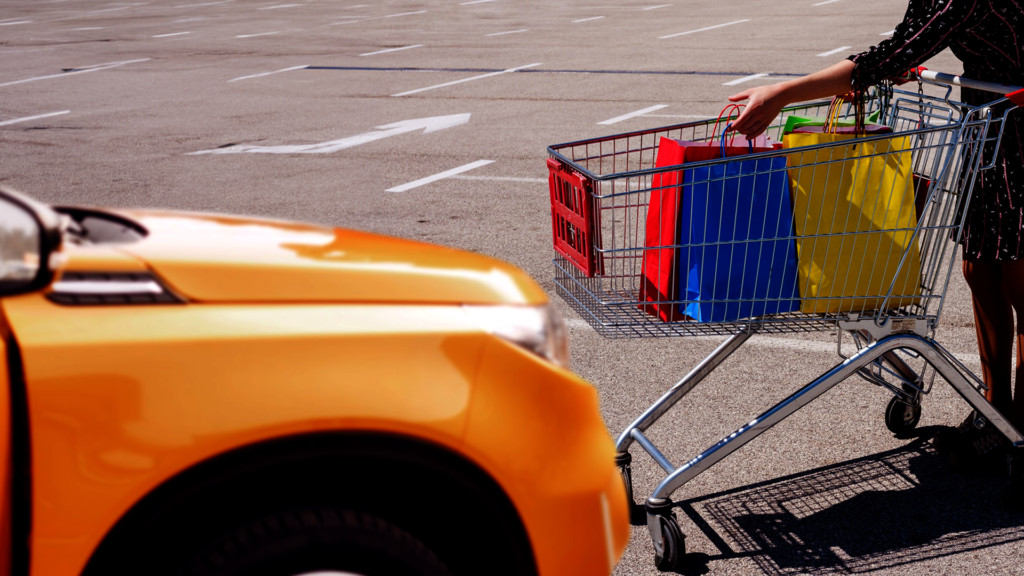 car with a dent from a shopping cart
car with a dent from a shopping cart
Example 2: Tree Branch Scratches
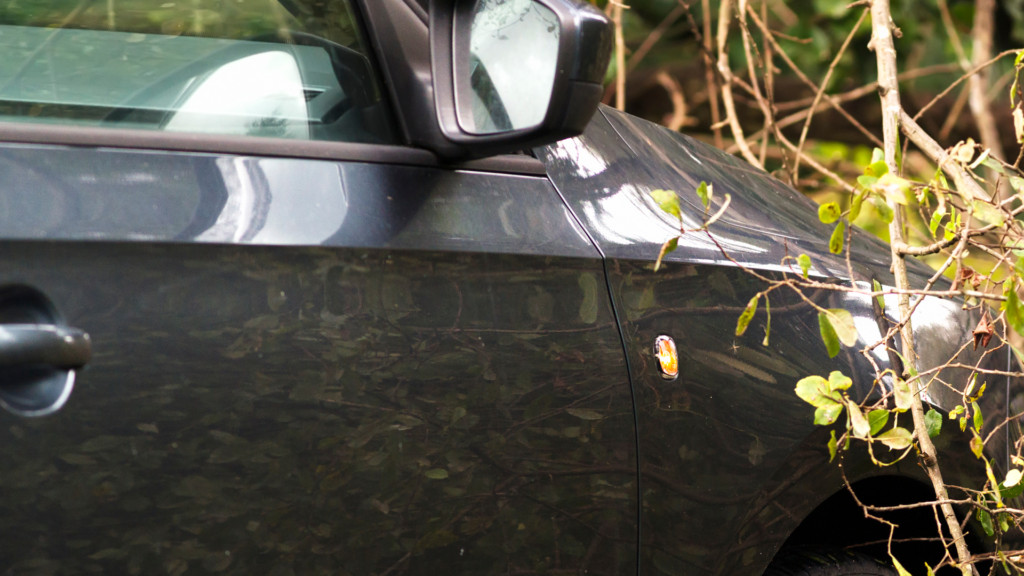 car with scratches from a tree branch
car with scratches from a tree branch
Example 3: Minor Scratches from Road Debris
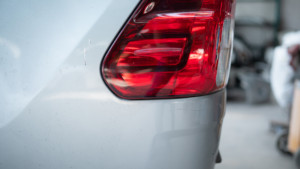 car with small paint chips and scratches on the hood or bumper
car with small paint chips and scratches on the hood or bumper
2.2. Extensive Work: Major Collision Repairs
Major collision repairs, on the other hand, can take anywhere from 1 to 3 weeks. These involve more complex issues such as:
- Frame damage
- Mechanical problems
- Airbag replacements
These repairs require specialized work and may involve waiting for specific parts. The complexity and need for precision extend the overall time to complete.
Example 1: Rear-End Collision
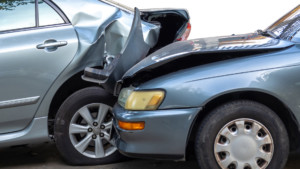 car with rear end damage, including a crushed trunk and a damaged bumper
car with rear end damage, including a crushed trunk and a damaged bumper
Example 2: Side-Impact (T-Bone) Collision
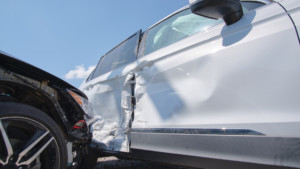 car with side impact damage, including a crushed door and a damaged side panel
car with side impact damage, including a crushed door and a damaged side panel
Example 3: Parking Lot Collision with a Pole or Barrier
 car with frontend damage from hitting a pole or barrier, including a damaged bumper and a bent fender
car with frontend damage from hitting a pole or barrier, including a damaged bumper and a bent fender
2.3. Severe Collision Damage
For very severe damage, such as extensive frame damage or when hard-to-find parts are needed, repairs can extend beyond 3 weeks. The more severe the damage, the longer the repair time.
Example 1: High-Speed Head-On Collision
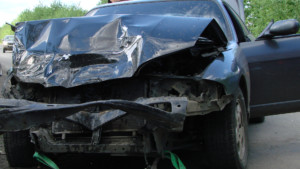 car with severe frontend damage, including a crushed front end, crumpled hood, and broken windshield
car with severe frontend damage, including a crushed front end, crumpled hood, and broken windshield
Example 2: Rollover Accident
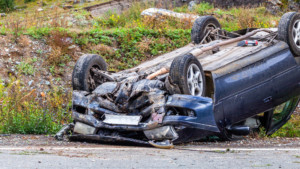 car that has rolled over, showing damage to the roof, sides, and possibly the undercarriage
car that has rolled over, showing damage to the roof, sides, and possibly the undercarriage
Example 3: Severe Side-Impact (T-Bone) Collision at High Speed
 car with severe side impact damage, including a crushed door, damaged side panel, and potentially a damaged frame
car with severe side impact damage, including a crushed door, damaged side panel, and potentially a damaged frame
3. Stages of the Collision Repair Process
Understanding the different stages involved in collision repair can provide a clearer picture of the overall timeframe. Here are the key phases:
3.1. Assessment and Estimation
The first step involves a thorough examination of the damage. A repair facility assesses the extent of the damage, estimates the time and cost of repairs, and prepares the necessary paperwork.
Timeframe: Many auto repair shops take several hours to a day or longer to provide an accurate estimate. CARDIAGTECH.NET offers tools and diagnostic equipment that can speed up this process, ensuring quicker and more accurate estimates. Contact us at +1 (641) 206-8880 to learn more.
3.2. Insurance Approval
If you’re using an insurance policy, the insurance company will need to review and approve the estimate. This may involve negotiations based on the required repairs and costs.
Timeframe: Typically 3 to 5 days.
3.3. Ordering and Receiving Parts (if needed)
Depending on the damage and the vehicle, the repair shop may need to order replacement parts. The availability of these parts can significantly impact the overall repair time.
Timeframe: 1-2 hours to 1-2 days.
3.4. Body Repair and Painting
This stage involves the actual vehicle repair. It includes restoring the vehicle to factory specifications, removing dents, replacing parts, and applying premium paint to restore the vehicle’s aesthetic.
Timeframe: 1 day to 4 weeks, depending on damage and other factors.
3.5. Reassembly and Quality Control
In this final stage, all detail pieces and moldings are reassembled. The vehicle is then washed, cleaned, and thoroughly inspected to ensure everything looks great and functions correctly.
Timeframe: This can vary from a few hours to a day, depending on the complexity.
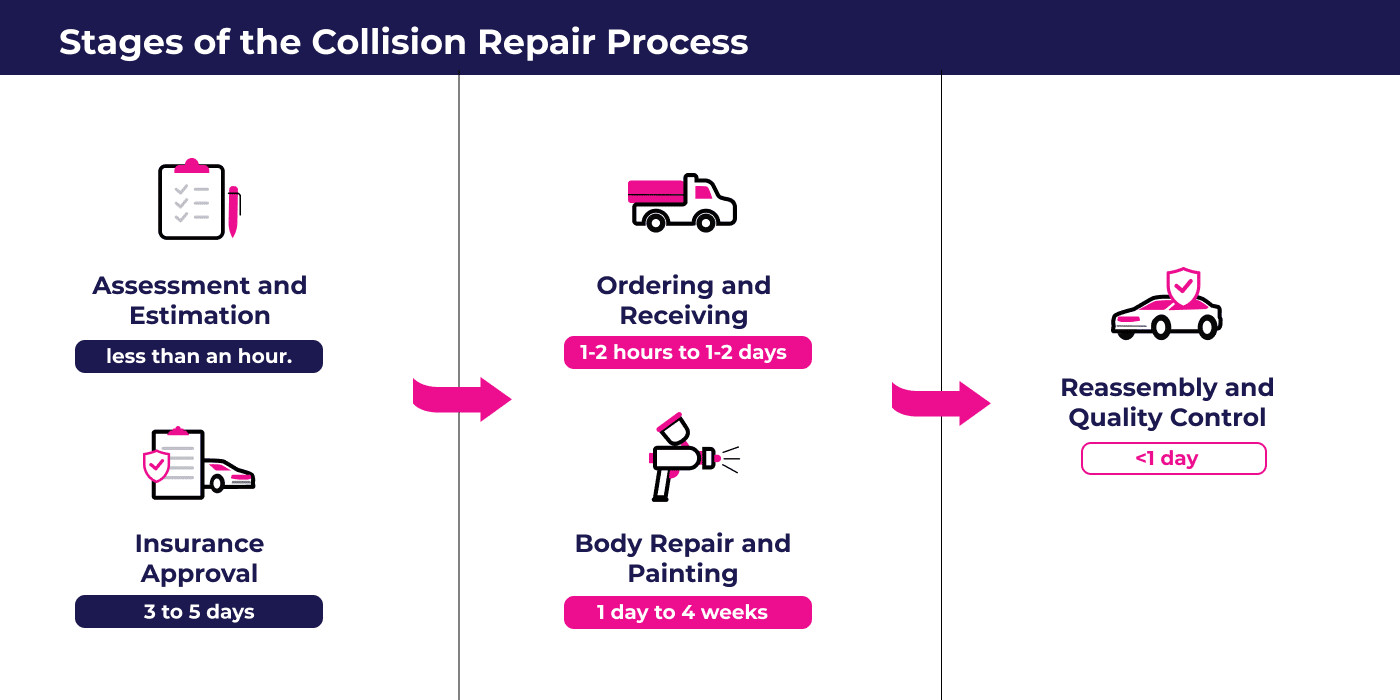 Stages of the Collision Repair Process
Stages of the Collision Repair Process
4. Factors Affecting Collision Repair Time
Several factors can influence the length of time it takes to repair a car after a collision. Being aware of these can help you anticipate potential delays.
4.1. Severity of Damage
The extent of the damage is a primary factor affecting repair time. Minor issues like scratches or small dents can be fixed quickly, while major damage involving structural components or multiple parts replacement will take longer.
4.2. Availability of Replacement Parts
The availability of replacement parts directly impacts repair time. Common parts for popular vehicle models are usually readily available, reducing delays. However, rare or custom parts can take several days or weeks to arrive, extending the overall repair time.
4.3. Type of Vehicle
The type of vehicle can also affect the repair timeline. Common vehicles often have readily available parts, making repairs faster. Luxury or rare vehicles may require specialized parts and technicians, which can increase the repair time.
4.4. Insurance Company Involvement
Dealing with insurance claims can add time to the repair process. Claim filing, estimate approvals, and potential negotiations can extend the overall timeline.
4.5. Repair Shop Workload
The workload of the repair shop can influence how quickly your vehicle is repaired. A busy shop may experience delays due to the volume of vehicles being serviced.
 Factors Affecting Collision Repair Time
Factors Affecting Collision Repair Time
5. Maximizing Efficiency: How CARDIAGTECH.NET Can Help
At CARDIAGTECH.NET, we understand the challenges faced by auto body shops in providing timely and efficient repairs. Our range of diagnostic and repair tools is designed to streamline the repair process, reduce downtime, and improve overall efficiency.
5.1. Advanced Diagnostic Tools
Our advanced diagnostic tools enable technicians to quickly and accurately assess vehicle damage. This helps in creating precise repair estimates and identifying the necessary parts, minimizing delays in the initial assessment phase.
5.2. Efficient Repair Equipment
CARDIAGTECH.NET offers state-of-the-art repair equipment that enhances the efficiency of body repairs. From dent pullers to welding machines, our tools are designed to help technicians perform repairs quickly and effectively.
5.3. Streamlined Parts Ordering
We provide access to a vast network of parts suppliers, ensuring that repair shops can quickly source the necessary components. This minimizes the waiting time for parts and keeps the repair process on track.
5.4. Training and Support
CARDIAGTECH.NET offers comprehensive training and support to help technicians effectively use our tools and equipment. This ensures that repair shops can maximize the benefits of our products and provide high-quality repairs in a timely manner.
6. The Role of Technology in Reducing Repair Time
Technology plays a crucial role in modern auto body repair. Advanced tools and equipment not only improve the accuracy of repairs but also significantly reduce the time required to complete them.
6.1. Diagnostic Scanners
Diagnostic scanners quickly identify issues with a vehicle’s systems, reducing the time spent on manual inspections. These scanners can pinpoint problems with the engine, transmission, airbags, and other critical components.
6.2. Computerized Color Matching
Computerized color matching systems ensure accurate paint colors, eliminating the need for multiple color tests. This technology matches the exact color of the vehicle, providing a seamless finish in less time.
6.3. Laser Frame Alignment
Laser frame alignment systems provide precise measurements for frame straightening, ensuring that the vehicle’s structure is restored to its original specifications. This advanced technology reduces the time and labor required for frame repairs.
7. Choosing the Right Body Shop: What to Look For
Selecting the right body shop is essential for ensuring a smooth and efficient repair process. Here are some key factors to consider:
7.1. Reputation and Reviews
Check online reviews and ask for recommendations to gauge the reputation of the body shop. A reputable shop will have positive feedback and a track record of providing high-quality repairs.
7.2. Certifications and Training
Ensure that the body shop is certified by industry organizations and that its technicians are properly trained. Certifications demonstrate that the shop meets specific standards and has the expertise to perform repairs correctly.
7.3. Equipment and Technology
Choose a body shop that invests in advanced equipment and technology. Modern tools can improve the accuracy and efficiency of repairs, reducing the overall repair time.
7.4. Insurance Compatibility
Verify that the body shop works with your insurance company. A shop that has experience handling insurance claims can streamline the process and minimize delays.
7.5. Warranty and Guarantees
Ask about the shop’s warranty and guarantees. A reputable shop will stand behind its work and offer a warranty on repairs, providing peace of mind.
8. Understanding Auto Body Repair Costs
Auto body repair costs can vary widely depending on the extent of the damage, the type of vehicle, and the repair shop. Here are some general guidelines:
| Repair Type | Average Cost |
|---|---|
| Minor Scratch Repair | $150 – $300 |
| Paintless Dent Repair | $100 – $500 |
| Bumper Repair/Replacement | $300 – $1,000 |
| Fender Repair/Replacement | $500 – $1,500 |
| Door Repair/Replacement | $700 – $2,000 |
| Frame Straightening | $500 – $2,000 |
| Major Collision Repair | $2,000 – $10,000+ |
| Full Vehicle Restoration | $10,000 – $100,000+ |
8.1. Factors Affecting Cost
Several factors can influence the cost of auto body repair, including:
- The severity of the damage
- The type of vehicle
- The availability of replacement parts
- The labor rates of the repair shop
- The use of OEM (Original Equipment Manufacturer) or aftermarket parts
8.2. Getting an Accurate Estimate
To get an accurate estimate, it’s essential to visit a reputable body shop and have them thoroughly assess the damage. A detailed estimate should include a breakdown of all costs, including parts, labor, and any additional services.
8.3. Insurance Coverage
If you have collision coverage, your insurance policy may cover the cost of repairs. Review your policy and contact your insurance company to file a claim.
9. Maintaining Your Vehicle to Prevent Future Repairs
Preventive maintenance can help reduce the likelihood of future auto body repairs. Here are some tips:
9.1. Regular Inspections
Conduct regular inspections of your vehicle to identify potential issues early on. Check for dents, scratches, and other signs of damage.
9.2. Proper Maintenance
Follow the manufacturer’s recommended maintenance schedule to keep your vehicle in good condition. This includes regular oil changes, tire rotations, and fluid checks.
9.3. Safe Driving Habits
Practice safe driving habits to reduce the risk of accidents. Avoid speeding, distracted driving, and other risky behaviors.
9.4. Protective Measures
Take protective measures to safeguard your vehicle from damage. Park in covered areas to protect it from hail and other weather-related damage. Use car covers to prevent scratches and dings.
10. Why Choose CARDIAGTECH.NET for Your Auto Body Repair Needs
CARDIAGTECH.NET is committed to providing high-quality diagnostic and repair tools that help auto body shops deliver efficient and reliable repairs. Our products are designed to streamline the repair process, reduce downtime, and improve overall efficiency.
10.1. Comprehensive Solutions
We offer a comprehensive range of solutions for auto body repair, including diagnostic tools, repair equipment, and parts sourcing. Our products are designed to meet the needs of both small and large repair shops.
10.2. Advanced Technology
CARDIAGTECH.NET stays at the forefront of technology, providing our customers with the latest tools and equipment. Our advanced solutions help repair shops improve the accuracy and efficiency of their repairs.
10.3. Expert Support
We provide expert support to help our customers effectively use our products. Our team of experienced technicians and engineers is available to answer questions, provide training, and offer technical assistance.
10.4. Commitment to Quality
CARDIAGTECH.NET is committed to quality, ensuring that our products meet the highest standards. We stand behind our products and offer warranties to provide peace of mind.
10.5. Customer Satisfaction
Customer satisfaction is our top priority. We strive to provide exceptional service and support, ensuring that our customers are completely satisfied with our products and services.
Ready to optimize your auto body repair process? Contact CARDIAGTECH.NET today at +1 (641) 206-8880 or visit our website at CARDIAGTECH.NET. Our address is 276 Reock St, City of Orange, NJ 07050, United States. Let us help you streamline your operations and deliver timely, high-quality repairs.
Are you facing delays in your auto body repairs? Contact CARDIAGTECH.NET today for a consultation on how our advanced tools and equipment can speed up your repair process and improve efficiency. Call us at +1 (641) 206-8880 or visit CARDIAGTECH.NET for more information.
11. Navigating Insurance Claims for Faster Repairs
Dealing with insurance companies can often be a bottleneck in the repair process. Here’s how to navigate insurance claims efficiently to expedite your car repairs:
11.1. Understand Your Policy
Familiarize yourself with your insurance policy’s terms and conditions. Know what types of damage are covered, the deductible amount, and any specific requirements for filing a claim.
11.2. Prompt Reporting
Report the accident to your insurance company as soon as possible. Provide all necessary information, including the date, time, and location of the accident, as well as details about the damage and any other parties involved.
11.3. Documentation
Gather all relevant documentation, such as police reports, photos of the damage, and witness statements. This information will support your claim and help expedite the approval process.
11.4. Choose a Compatible Repair Shop
Select a body shop that has experience working with your insurance company. These shops are familiar with the insurance claim process and can help streamline the approval and payment procedures.
11.5. Communicate Effectively
Maintain open and clear communication with your insurance adjuster and the repair shop. Respond promptly to any requests for information and keep them updated on the progress of your repairs.
12. Addressing Common Challenges in Auto Body Repair
Auto body repair can present several challenges that may impact the repair time. Here’s how to address these common issues:
12.1. Parts Backorders
Parts backorders can significantly delay repairs. To mitigate this issue, work with a repair shop that has a vast network of suppliers and can quickly source the necessary parts.
12.2. Hidden Damage
Hidden damage, such as structural issues or mechanical problems, may not be immediately apparent. A thorough inspection using advanced diagnostic tools can help identify hidden damage early on and prevent delays.
12.3. Complex Repairs
Complex repairs, such as frame straightening or advanced paint work, require specialized expertise and equipment. Choose a repair shop that has the necessary skills and tools to handle these complex repairs efficiently.
12.4. Regulatory Compliance
Auto body repair shops must comply with various regulations related to safety, environmental protection, and quality standards. Ensure that the shop you choose is fully compliant with all applicable regulations.
13. Future Trends in Auto Body Repair
The auto body repair industry is constantly evolving, with new technologies and techniques emerging all the time. Here are some future trends to watch for:
13.1. Electric Vehicle (EV) Repairs
As electric vehicles become more common, auto body shops will need to adapt to the unique repair requirements of these vehicles. This includes specialized training, equipment, and safety procedures for handling high-voltage systems.
13.2. Advanced Driver Assistance Systems (ADAS)
Advanced Driver Assistance Systems (ADAS) are becoming increasingly prevalent in modern vehicles. Repairing vehicles with ADAS requires specialized knowledge and equipment to ensure that these systems are properly calibrated and functioning correctly.
13.3. 3D Printing
3D printing is being used to create custom parts and components for auto body repair. This technology can help reduce the time and cost of repairs, particularly for rare or hard-to-find parts.
13.4. Augmented Reality (AR)
Augmented Reality (AR) is being used to assist technicians in diagnosing and repairing vehicles. AR systems can provide real-time information and guidance, helping technicians perform repairs more efficiently and accurately.
14. Tools and Equipment for Efficient Body Repairs at CARDIAGTECH.NET
At CARDIAGTECH.NET, we pride ourselves on providing cutting-edge tools that meet the diverse needs of auto body repair professionals. Here are some of the top tools we offer:
| Tool Category | Tool Name | Description | Benefits |
|---|---|---|---|
| Diagnostic Scanners | Autel MaxiSYS MS909EV | Comprehensive diagnostic tool that supports advanced ECU coding and programming for a wide range of vehicles, including electric and hybrid models. | Fast, accurate diagnostics; comprehensive vehicle coverage; advanced programming capabilities. |
| Welding Machines | YESWELDER Digital MIG-205DS | Versatile welding machine suitable for MIG, TIG, and stick welding, providing excellent performance for various metal types and thicknesses. | Multi-process capabilities; digital controls for precise settings; portability. |
| Dent Repair Kits | GLISTON 72 Pcs Car Dent Puller Kit | Complete kit with a variety of tools for paintless dent removal, including slide hammers, glue pullers, and dent lifters. | Efficient dent removal; preserves vehicle paint; cost-effective. |
| Frame Straighteners | Chief Automotive Technologies Impulse E/V | Advanced frame straightening system that uses laser measuring technology to ensure precise and accurate frame repairs. | Accurate frame measurements; efficient straightening process; restores vehicle to factory specifications. |
| Paint Systems | SATAjet 5000 B HVLP | High-performance spray gun that provides excellent atomization and paint distribution for a flawless finish. | Superior paint finish; reduced overspray; optimized paint consumption. |
| Measuring Tools | FARO ScanArm | Portable coordinate measuring machine that captures precise 3D measurements of vehicle components for accurate repair planning and execution. | High-precision measurements; real-time data feedback; portable design. |
| Air Compressors | Ingersoll Rand Two-Stage Air Compressor | Robust and reliable air compressor that delivers consistent air pressure for powering pneumatic tools and equipment. | Reliable performance; high air output; durable construction. |
| Lifting Equipment | BendPak Four-Post Lift | Heavy-duty four-post lift that provides safe and stable lifting for a wide range of vehicles, facilitating easy access for repairs. | Safe and stable lifting; versatile; easy to use. |
| Power Tools | Milwaukee M18 Cordless Impact Wrench | Powerful and versatile cordless impact wrench that provides high torque for removing stubborn fasteners and speeding up disassembly. | Cordless convenience; high torque output; durable design. |
| Surface Preparation Tools | Festool Rotex RO 150 FEQ Multi-Mode Sander | Multi-mode sander suitable for coarse sanding, fine sanding, and polishing, providing excellent surface preparation for painting and refinishing. | Versatile sanding capabilities; efficient material removal; smooth surface finish. |
15. The Importance of Continuous Training for Auto Body Technicians
The auto body repair industry is rapidly evolving, with new technologies and repair techniques emerging all the time. To stay competitive and provide high-quality repairs, auto body technicians must engage in continuous training and professional development.
15.1. Staying Up-to-Date with New Technologies
Continuous training helps technicians stay up-to-date with the latest technologies, such as electric vehicle repairs, ADAS calibration, and advanced diagnostic tools. This knowledge enables them to handle complex repairs efficiently and accurately.
15.2. Enhancing Skills and Expertise
Training programs can enhance technicians’ skills and expertise in various areas, such as welding, painting, frame straightening, and dent repair. This leads to improved repair quality and reduced repair times.
15.3. Improving Safety Practices
Continuous training reinforces safety practices and ensures that technicians are aware of the latest safety protocols and procedures. This reduces the risk of accidents and injuries in the workplace.
15.4. Meeting Industry Standards
Many industry certifications and standards require ongoing training to maintain credentials. By participating in continuous training, technicians can ensure that they meet these requirements and demonstrate their commitment to quality.
16. How to Evaluate the Expertise of a Body Shop
When you entrust your vehicle to a body shop, you’re placing your safety and investment in their hands. Here are some essential ways to evaluate the expertise of a body shop:
16.1. Certifications and Accreditation
Look for certifications from reputable organizations such as I-CAR (Inter-Industry Conference on Auto Collision Repair) and ASE (Automotive Service Excellence). These certifications indicate that the technicians have met specific training and competency standards.
16.2. Years of Experience
A body shop with many years of experience is more likely to have encountered a wide range of repair scenarios and developed effective solutions. Consider shops with a long history of serving the community.
16.3. Customer Testimonials and Reviews
Check online reviews and testimonials to gauge the experiences of other customers. Look for patterns in the feedback, both positive and negative, to get a sense of the shop’s strengths and weaknesses.
16.4. Equipment and Technology
A well-equipped body shop is a sign that the business is committed to staying current with industry best practices. Ensure that the shop has modern diagnostic tools, welding machines, paint systems, and frame straightening equipment.
16.5. Repair Process Transparency
A reputable body shop should be transparent about their repair process, providing you with detailed estimates, regular updates, and clear explanations of the work being performed. They should also be willing to answer your questions and address your concerns.
17. Environmental Considerations in Auto Body Repair
Environmental responsibility is becoming increasingly important in the auto body repair industry. Here are some environmental considerations that shops are adopting:
17.1. Waterborne Paints
Traditional solvent-based paints release harmful volatile organic compounds (VOCs) into the atmosphere. Waterborne paints contain fewer VOCs and are more environmentally friendly.
17.2. Recycling
Body shops can recycle various materials, including metal scrap, plastic components, and waste fluids. Recycling reduces waste and conserves natural resources.
17.3. Energy Efficiency
Energy-efficient equipment and practices can reduce the environmental impact of body shop operations. This includes using LED lighting, energy-efficient air compressors, and properly insulated buildings.
17.4. Waste Management
Proper waste management practices are essential for preventing pollution and protecting the environment. This includes safely disposing of hazardous waste materials, such as paint thinners, solvents, and used oil.
18. The Impact of New Car Technologies on Repair Times
The automotive industry is constantly evolving, with new technologies being introduced in vehicles every year. Here’s how some of these technologies can impact repair times:
18.1. Advanced Materials
Modern vehicles often use advanced materials, such as high-strength steel, aluminum alloys, and carbon fiber composites, to improve fuel efficiency and safety. Repairing these materials requires specialized techniques and equipment, which can increase repair times.
18.2. Sensor Integration
Many new cars are equipped with an array of sensors for ADAS and other systems. Repairing vehicles with integrated sensors requires careful calibration and alignment to ensure that these systems function properly.
18.3. Complex Electrical Systems
The electrical systems in modern vehicles are becoming increasingly complex, with numerous electronic control units (ECUs) and networked components. Diagnosing and repairing electrical issues can be time-consuming and require specialized diagnostic tools.
18.4. Cybersecurity Measures
Some new cars incorporate cybersecurity measures to protect against hacking and data breaches. Repairing these vehicles may require additional steps to ensure that the cybersecurity systems are not compromised during the repair process.
19. Common Auto Body Repair Scams and How to Avoid Them
Unfortunately, some unscrupulous operators in the auto body repair industry engage in scams and fraudulent practices. Here are some common scams and how to avoid them:
19.1. Inflated Estimates
Some body shops may inflate their estimates by including unnecessary repairs or charging excessive prices for parts and labor. Get multiple estimates from different shops and compare them carefully.
19.2. Substandard Parts
Dishonest shops may use low-quality or counterfeit parts in their repairs, which can compromise the safety and reliability of your vehicle. Insist on OEM or reputable aftermarket parts and ask to see documentation of the parts used.
19.3. Unnecessary Repairs
Some shops may recommend repairs that are not actually necessary or perform work without your authorization. Always get a detailed explanation of the repairs being recommended and ask for written approval before any work is done.
19.4. Insurance Fraud
Some body shops may collude with customers to commit insurance fraud, such as exaggerating the extent of the damage or filing false claims. Avoid any shop that encourages or participates in such practices.
19.5. Bait-and-Switch Tactics
Some shops may lure customers in with low prices or special offers, then switch to higher prices or inferior services once the work has begun. Get all terms and conditions in writing before agreeing to any repairs.
20. Average Collision Repair Time FAQs
20.1. What do I use for transportation while my car is in the shop?
Whether you had a car accident or some other type of damage, finding transportation can be stressful. You may have options for transportation while your vehicle is getting collision repair. In some cases, your insurance provider may cover a rental car, for example.
20.2. Do you offer an automotive repair warranty?
Yes! Many reputable auto body shops offer a warranty on their work.
20.3. How long does it take to fix a front-end collision vs rear-end collision?
While it depends on many factors, rear-end repairs are often cheaper and faster than front-end repairs. That’s because the front of your vehicle has the grill, engine, radiator, hood, windshield, and other considerations.
20.4. When is my car considered a total loss?
When the cost of repairs exceeds the value of the car, or often when it exceeds around 70-75% of the value of the car, then the insurance company will likely consider it totaled. While you can still get the vehicle repaired, the insurance provider will only pay the value of the vehicle and you’ll have to pay any remaining costs.
20.5. What do I do if it’s taking much longer than originally estimated?
If your mechanic is taking significantly longer than originally estimated, then you can call your insurance company to consider taking your vehicle to another garage. However, we recommend talking to your auto body shop to see what might be holding up repairs because another shop may have the same issue if it has something to do with your insurance claim, difficulty getting parts, or other supply chain issues.
20.6. How much does collision repair cost?
Collision repair costs can vary greatly depending on a number of factors.
Understanding how long body shops take to fix cars involves considering several factors, from the severity of the damage to the availability of parts and the repair shop’s workload. CARDIAGTECH.NET is dedicated to equipping auto body shops with the tools and technology they need to provide efficient and reliable repairs. By choosing the right body shop and staying informed about the repair process, you can ensure that your vehicle is back on the road as quickly as possible.



